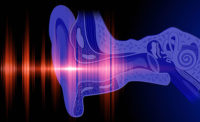Poor noise discipline is not only harmful, it is expensive. NIOSH reports that an estimated $242 million is spent annually on workers’ compensation for hearing loss disability. The Department of Veterans Affairs spent an estimated $1.39 billion in calculated compensation for major auditory disabilities in FY2010.
Sound and sound descriptors
Sounds are air pressure variations that are typically a mixture of random, impulsive, and tonal components. An example of a random sound is the “hiss” of wind rushing in an open car window. An impulsive sound is “bang-bang-bang” of a stamping mill. A tonal sound is the droning from a prop plane flying overhead.
We describe these sounds by their respective frequency or frequency range, loudness, and duration. The frequency is the rate of repetition as measured in cycles-per-second or hertz (Hz). The loudness and duration are simply the level and length of time of the sound.
A-weighting and measurement of the perceived sound
In 1933, Fletcher and Munson had test subjects listen to a reference tone and adjust a second tone of differing frequency until the two tones sounded “equally loud.” From this, Fletcher and Munson generated a collection of relative loudness “weighting curves” that depended upon overall loudness.
Early sound level meters included a “quiet” curve of Fletcher and Munson’s labeled “A” in the original research paper. This curve became the A-weighting curve (dBA). Soon after, a louder curve from the paper labeled “C” was incorporated into commercial meters as the C-weighting curve (dBC). It was left to the user to choose the appropriate scale based on overall loudness level (A for quieter environments, C for louder environments). The difference between the curves is paramount to the valid measurement of perception.
The A-weighting — for quieter environments — filters out the low frequency sound components prior to measurement. This means that — for louder environments — the invalid use of the A-weighting scale would underestimate perceived loudness.
Another problem is that perceived loudness tells us nothing of the harmful or dangerous nature of the sound. Harmful aspects of sound exposure relate to physiological concerns such as hearing loss and heart damage. Dangerous aspects of sound exposure relate to safety concerns such as noise-induced fatigue, interference with communications, etc.
Equating perception to harmfulness or danger is not valid. It turns out that low frequency noise (LFN) causes a wide array of health issues. Studies have linked LFN to wide-frequency cochlea damage [ETSI 2000]; heart infarct, chronic insomnia and depression [Mirowska 2000]; fatigue [Holmberg 1999, Johansson 2000]; drowsiness [Landstrom 1985]; poor test performance [Bengtsson 2000]; and, reduced speech intelligibility [Songer 1992]. This means that the valid measurement of LFN is of critical importance to workplace safety.
Sound level measurement for regulation
In an effort to simplify the regulation of sounds, the U.S. Federal Government — and many others — have focused on instantaneous and time-averaged sound pressure level only. Noise regulation for U.S. federal workers can be traced back to 1969, when the Walsh-Healy Act established noise exposure limits for federal workers in dBA. Since then, we have seen a steady stream of federal regulations and private standards dictating the use of the A-weighting scale in increasingly loud and low frequency-dominant environments.
U.S. examples include:
• Agency/Organization Document Number
• OSHA Permissible Exposure Limit 29CFR1910.95
• NIOSH Recommended Exposure Limit DHHS98-126
• US Military Hearing Conservation Instruction 6055.12
• MSHA Uniform Mine Health Regulations 30CFR62.0
• SAE Heavy Truck Interior/Exterior J336/J366
• FRA Railroad Noise Emission
• Compliance Regulation
• 49CFR210
The Federal Railroad Administration is an example of a misguided regulation. Locomotive cabs are characterized by high levels of low frequency tonal noise. The de-emphasis of these sound components by the A-weighted scale means that railroads can meet the “letter of the law” and still have engineers and conductors experiencing hearing and overall health problems.
Regulation flexibility
Some regulations attempt to list “acceptable” engineering controls — which are proven engineering solutions. This puts commercial technology developers in a difficult position because it is commercially risky to invest in a new technology in the hopes that they will eventually be added to an acceptable controls list.
Noise regulations in Scandinavia and the EC take a much more proactive approach to noise regulations. The Scandinavians have adopted the use of alternative weighting scales for industrial workplace settings. The EU Noise Directive (2002/49/EC) is the most flexible by acknowledging that noise environments are unique and encouraging the industrial hygienist to establish a valid method of assessment and consistently applying it.
U.S. regulations would benefit from either of these approaches.
Lessons learned
The most important lesson from the history of noise measurement and regulation is that new regulations and standards should not be built from old ones. Measurement standards should be appropriate for the noise levels and spectral content specific to the environment being regulated. The continued re-adoption of the Walsh-Healy Act has been at the expense of the hearing of many American workers.
A second lesson is that regulations should be flexible in approaches and requirements. And rely upon an intelligent assessment of actual noise exposure. Meeting the “letter of the law” is not enough. An 85dBA/8 hour low frequency tonal noise dominant setting can still be harmful. Additional protections such as active ear defenders should be considered in the cases for true protection of workers.



